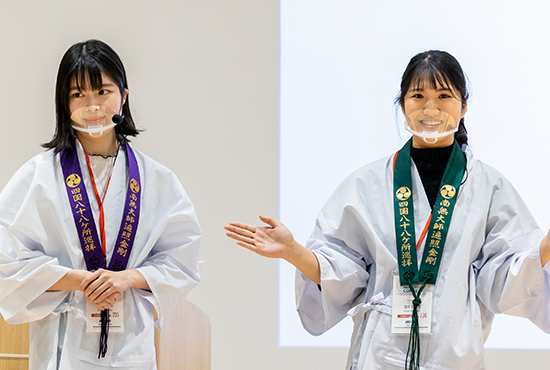




左から
東山 成美さん Higashiyama Narumi
京都大学 文学部 4年
浅井 菜々子さん Asai Nanako
同志社大学 商学部 3年
遠藤 日菜子さん Endo Hinako
京都大学大学院 農学研究科 1年
Have you ever been to Shikoku? Shikoku is an island full of nature, surrounded by peaceful seas. Today we are going to share our plan of utilizing the unstaffed stations in Shikoku.
Why did we choose the stations in Shikoku in the first place?
This is a map showing how JR stations are distributed in Shikoku. How many of these stations do you think are unstaffed? So how many are there? 208 of 259 are unstaffed stations.
The unstaffed station rate in Shikoku exceeds 80%, which is the highest rate in Japan.

In terms of revenues, Shikoku is in an extremely difficult situation.
Of all japan railway group companies, JR Hokkaido and JR Shikoku are in the red, with a deficit of 11. 4 billion yen last year.
I was born and raised in Kochi in the Shikoku island.
So, let me introduce our plan to save the railway industry in Shikoku from this situation.
Yes, we have a plan.
The plan is named OhenRail.
It combines "railway” with "Ohenro".
Do you know what Ohenro is?
It is one of the famous pilgrimages in Japan.
It includes 88 official temples and numerous other sacred sites where the Buddhist priest Kūkai had lived and meditated during the 9th Century.
The entire route is about 1,200 kilometers long and it takes 50-60days, on foot, to complete all “88” temples.
Ohenro gives us an opportunity to reflect on our lives and make them better.
Shikoku is the island with the fewest tourists in Japan out of the main four, but the number of foreign visitors who try Ohenro has increased about ten times in the last 10 years.So, they can potentially revitalize Shikoku tourism.
The plan aims to address the potential needs of foreign visitors.
In general, foreign visitors are more interested in religion than Japanese.
We expect tourists to come, inter alia, from Asian countries.
It is because most foreign visitors to Shikoku have been to Japan more than a few times and more than 80% of repeat visitors to Japan are from Asian countries.
And as you know, there are many Buddhists in Asia.
Foreign pilgrims tend to face a number of problems in their Ohenro journey.
That is, problems in language, accommodation, local transport, and internet connection.
OhenRail allows us to solve these problems with new services and features, thus helping to increase the number of pilgrims and thereby reinvigorate unstaffed stations.
Today, we propose three key ideas for the plan.
Using stations as hostels for pilgrims, using them as an information hub at the same time, and lastly OhenRail pass.
The first key idea is station hostels.
Accommodation fees can be problematic for young people and foreign backpackers.
Compared to overseas pilgrimage hostels, hostels in Shikoku are often expensive at around 7,000 yen per night, and the number of hotels is not sufficiently many.
So, there are many people who have no choice but to sleep outdoors.
How can we keep accommodation fees reasonable?
For example, on the pilgrimage of Compostela in Spain, which is a World Heritage Site, the government refurbished old buildings as hostels for pilgrims. There, they put a lot of simple beds in a large room like this picture to keep its cost down to about 10 euro per night.
Following this, our station hostels too, have minimalist services to minimize the costs.
The room is shared and no meals are included. There are few such simple and cheap hostels in Shikoku, so there will be demand not only from railway passengers but also from walking pilgrims.
The second key is to make unstaffed stations information centers for pilgrims to re-energize.
We set up footbaths, information boards, internet service and unattended stands.
Firstly, footbaths allow you to take some rest during the pilgrimage.
Many pilgrims are looking for opportunities to interact with locals, so this will be a good opportunity for communication.

Next, we set up information boards. The history, methods, and basic
etiquette of Ohenro are displayed on them in multiple languages.
You get lots of information to make Ohenro more enjoyable,
and you can use the internet as well.
Unstaffed stations thus serve as an information hub for Ohenro.
The last one is unattended stands.
Selling local products at unattended stands ensures that there are some foods available even in areas where there are few stores.
General unattended stands are often like this photo, but considering security, it is better to put locker-like vending machines.
With these services, more people will stop by at unstaffed stations.
The third one is “OhenRail pass”.
It comes with three benefits.
The first is unlimited rides. You can take trains whenever you want to, within the designated course. In fact, only Kagawa Prefecture allows for electronic passes in Shikoku.
Foreigners often do not have much change, and often have trouble with calculating fares, but using this Pass eliminates such concerns.
The second is a discount on admission fees. Presenting your pass will give you a discount on temple admission fees.
The third is the option to use rental bikes for free, which are especially convenient when the temple is far from the station,
For example, with a 4-day Pass, you can set up a course like this.
Here are sample details of a trip.
This is just a sample, so you can choose your own favorite temples.
Making different courses available, we can have repeat customers as well.
Now, by how much can we expect the number of visitors to increase?
This graph shows the number of foreign visitors of Kumano Kodo.
So, if foreigners come to Shikoku as much as Kumano Kodo by our OhenRail we can expect an increase of tens of thousands of foreign visitors.
In conclusion, let’s review the key ideas of OhenRail and how they work together.
The OhenRail pass will help people who want to do Ohenro by railway instead of walking, which will increase the overall number of people who try Ohenro.
Moreover, the quality of the Ohenro experience itself will be improved by introducing various services such as footbaths and hostels.
As a result, many tourists will gather at the unstaffed stations, and then the locals and volunteers who take care of the tourists will gather as well.
28 This is how our OhenRail will revitalize unstaffed stations in Shikoku.
Close your eyes and imagine the future of OhenRail stations.
Can you see the image of unstaffed stations in Shikoku with many people and diverse interactions?
Let’s create an exciting future of stations in Shikoku together.Thank you.

みなさんは四国を訪れたことがありますか。
四国は自然豊かで、穏やかな海に囲まれた島です。
本日、私たちは四国の無人駅を活用するプランについて提案させていただきます。
まず、わたしたちはなぜ、四国の駅を選んだのでしょうか。
これは、四国におけるJRの駅の分布を記した地図です。このうちどれくらいの駅が無人駅だと思いますか。 いくつあるのでしょうか。250駅のうち208駅が無人なのです。
四国の無人駅の比率は80%を超えており、その比率は日本で最も高いのです。
また、収益の面でも、四国はかなり苦しい状況にあります。
JR全7社のうち、JR北海道とJR四国が赤字を出しており、JR四国は昨年度、114億円の赤字でした。
私は四国にある高知で生まれ育ちました。
四国の鉄道業の苦しい状況を救うために私たちが考えたプランを紹介させていただきます。そう、私たちにはプランがあるのです。
プランの名前は「オヘンレイル(OhenRail)」です。
「Ohenro(お遍路)」と「Railway(レイルウェイ:鉄道)」を組み合わせたものです。
みなさんは、お遍路をご存知ですか?
お遍路は日本において有名な巡礼の旅のひとつです。
9世紀に仏教の僧侶、空海が暮らし、瞑想した88カ所の寺院とそのほかの数えきれない聖なる場所から成ります。
ルートの全行程は約1,200キロに及び、徒歩で88カ所の寺院を踏破するには50日から60日を要します。
お遍路は私たちに日々の暮らしを省みて、改善を促す機会をもたらしてくれます。
四国は日本の主要4島のうち、観光客が最も少ない島ですが、この10年でお遍路に挑戦する外国人観光客の数は約10倍に増えています。
ですから、そういった観光客が四国の観光を活性化する可能性があるのです。
私たちのプランは、これから増えていく外国人旅行者をターゲットとします。
一般的に外国人の方が日本人より宗教的関心の高い人が多くいます。
この中でも今回私たちがメインターゲットとするのはアジアからの観光客です。
四国訪問を検討する外国人は、来日経験が複数回以上あるリピーターが多く、リピーターの8割以上はアジア諸国からです。また、みなさんご存知の通り、アジア圏に仏教徒が多いのです。
外国人のお遍路さんは、お遍路の旅において数多くの問題に直面する傾向にあります。
言葉、宿泊、現地での移動、インターネット接続などの問題です。
OhenRailは、こういった諸問題を新たなサービスや機能で解決し、お遍路さんの増加を促し、それによって無人駅を活性化するのです。
本日は、OhenRail の3つのキーアイデアを提案します。
無人駅をお遍路さんの民泊施設として活用すること、無人駅をインフォメーションの拠点としての活用すること、そしてOhenRailパスです。
最初のキーアイデアは駅にある民泊施設です。
宿泊費は若い人々や外国人のバックパッカーにとって悩みの種となることがあります。
海外の巡礼宿と比べると四国のお遍路宿は一泊七千円程度と割高なことが多く、また宿の数も不足しています。
お遍路さんの中には野宿をせざるを得ない状況になる人も少なくありません。
では、どのようにすれば宿泊コストを抑えられるのでしょうか。
例えば、世界遺産になっているスペインのコンポステーラの巡礼道では、使われなくなった建物を政府が買い取り、巡礼者専用の宿として整備しています。
そこではこの写真のような大きな部屋に簡易的なベッドをたくさん置くなどして、1泊1000円程度にまで宿泊費を抑えています。
これを見習って、私たちの駅にある宿泊施設でもサービスを最低限にして、コストを最小限に抑えます。 部屋は相部屋で食事はつきません。 このようなシンプルで安価な宿は四国にほとんどないので、鉄道利用のお遍路さんのみならず歩き遍路さんにも需要があります。
2つ目のキーアイデアは無人駅をお遍路さんが活力を得るための情報の場にします。
無人駅に足湯や案内掲示板、インターネットサービス、良心市を設置します。
まず、足湯はお遍路で疲れた足を癒してくれます。
巡礼者の多くは地元の人々との交流を望んでいるので、ここがコミュニケーションの絶好の場となります。
次は、案内掲示板です。お遍路に関する歴史や巡礼・参拝の方法や基本的なマナーなどを多言語によって掲示します。
お遍路がもっと楽しくなる多くの情報を得るとともに、インターネットの使用も可能です。
無人駅はこのようにお遍路さんの情報ハブの役割を果たすのです。
3つ目のキーアイデアは良心市です。
無人の売店でご当地の産品を販売します。軽食代わりになるものを販売することで、店舗がほとんどないエリアでも食料を確保できます。
一般的な無人の売店はこの写真のようなものですが、セキュリティに配慮し、自動販売機のようなロッカータイプが好ましいと考えます。
こういったサービスの提供よって無人駅の活性化が見込めます。
3つ目のキーアイデアは「OhenRail lパス」です。OhenRail パス には3つの特典があります。
まず、1つ目は乗り放題です。決められたコース内であれば、いつでも電車に乗ることができます。実際、四国でICカードを使うことができるのは香川県しかありません。
外国人は小銭をあまり持たない人も多く、運賃の計算に苦労することも多いですが、このPassを使うことでそのような心配がなくなります。
2つ目は入場料の割引です。パスの提示によってお寺の拝観料が割引されます。
3つ目は無料レンタサイクルのオプションです。これは特に寺が駅から遠い時に非常に便利です。
例えば、4日間のパスを使えば、こういったコースを設定できます。
こちらが旅の詳細です。 これはあくまでもサンプルなので、もちろん自分の好きなお寺を選んでいくことができます。 何通りものコースを用意しておけばリピーター客も見込むことができます。
では、どのくらい人数の増加が見込めるのでしょうか。
このグラフは、熊野古道を訪れる外国人観光客の数です。
私たちのOhenRailのプランによって四国にも熊野古道と同じくらい外国人が来るようになれば、数万人の増加が見込めます。
では、結論として、OhenRailのキーアイデアを確認し、その相乗効果をみていきましょう。
OhenRailパスは、徒歩でなく鉄道でお遍路をしたい人々に役立ちます。結果、お遍路に挑戦する人の総数を増加させます。さらに、足湯や宿などご紹介したさまざまなサービスによってお遍路の体験の質が向上することでしょう。
結果として、多くの旅行者が無人駅を訪れ、旅行者の世話をする地元住民やボランティアもまたそこに集うのです。
これがOhenRailによる四国の無人駅の活用に関する私たちのプランです。
目を閉じて、OhenRail駅の未来を想像してください。数多くの人々が集い、多様な交流が生まれている四国の無人駅のイメージが見えてきましたか。
四国の駅のワクワクする未来を一緒につくっていきましょう。
ありがとうございました。